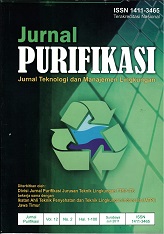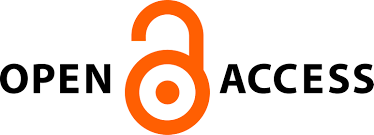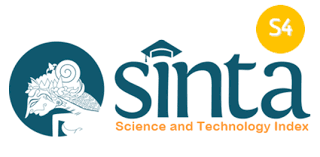APAKAH BREAKPOINT CHLORINATION SELALU APLIKATIF UNTUK MENGOLAH LIMBAH CAIR RUMAH SAKIT?
Main Article Content
Abstract
Chlorination is one of the wastewater treatment techniques are often used to kill pathogenic coliform bacteria in hospital wastewater treatment. However, the application of chlorine was positively correlated with the formation of toxic organohalogen compounds. Therefore, chlorine application should be based on the calculation of breakpoint chlorination (BPC) for environmental protection. By using wastewater samples from a hospital that use 5 mg/L chlorination dose, this study was conducted for determining the chlorination applicability at BPC. BPC point was determined by iodometric titration method and potassium permanganate. Based on the titration of potassium permanganate, wastewater samples containing organic materials of 39.79 mg/L, the active chlorine doses were tested at 30, 35, 40, 45, 50, 55, 60, and 65 mg/L. At all incubation periods of 0, 15, 30 and 45 minutes the BPC occurs at similar concentration of 55 mg/L. The dose was able to reduce coliform bacteria concentrations from 106 cells/100 mL to 200 cells/100 mL. If chlorination was only considered as a desinfectant, chlorination at BPC was questionable, because at 10 mg/L the coliform bacteria concentration could be reduced to 200 ml. In addition, the application of 55 mg/L chlorination left residual chlorine of 43 mg/L in average into the environment. This residual chlorine concentration was relatively high when compared to the real application (residual chlorine of 5 mg/L), although in this chlorine concentration the residual chlorine left coliforms of 105 ml cells/100 mL.
Downloads
Article Details
Submission of a manuscript to Jurnal Purifikasi means that the work has never been published in another journal and is not under consideration for publication elsewhere. The author hereby agrees to submit the copyright of the manuscript and its contents to Jurnal Purifikasi, if accepted for publication. Accepted manuscripts will be published in printed form where the ISSN is bound in printed form, not in online form (pdf). Authors are not allowed to publish their work in other forms (journals) without permission from the Jurnal Purifikasi manager.
By submitting a manuscript, the author is deemed to know all the rights and obligations attached to each manuscript.








